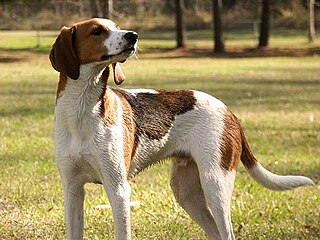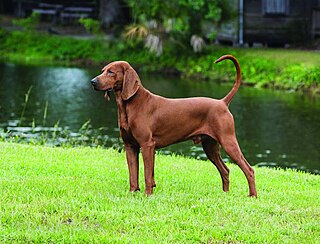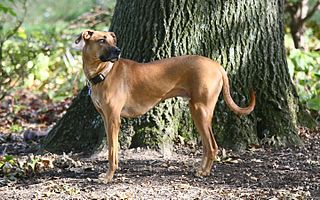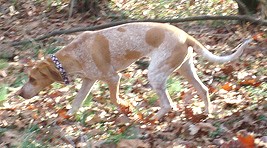
The Kooikerhondje is a small spaniel-type breed of dog of Dutch ancestry that was originally used as a working dog, particularly in an eendenkooi to lure ducks. Kooikers were popular in the 17th and 18th century and appear in the paintings of Rembrandt, Gerard ter Borch, and Jan Steen. The breed is gaining popularity in the United States, Canada and Scandinavia, where it is still relatively unknown.

The Catahoula Leopard Dog is an American dog breed named after Catahoula Parish, Louisiana. It became the state dog of Louisiana in 1979. It is recognized by the United Kennel Club under the name Louisiana Catahoula Leopard Dog, while the American Kennel Club Foundation Stock Service calls it Catahoula Leopard Dog. Both registries have assigned the breed a herding group designation, although it has traditionally been used in hunting feral boars.

The Boxer is a medium to large, short-haired dog breed of mastiff-type, developed in Germany. The coat is smooth and tight-fitting; colors are fawn, brindled, or white, with or without white markings. Boxers are brachycephalic, have a square muzzle, mandibular prognathism, very strong jaws, and a powerful bite ideal for hanging on to large prey. The Boxer was bred from the Old English Bulldog and the now extinct Bullenbeisser, which became extinct by crossbreeding rather than by a decadence of the breed. The Boxer is a member of both The Kennel Club and American Kennel Club (AKC) Working Group.

The Chinook is a breed of sled dog, developed in the state of New Hampshire during the early 20th century. The Chinook is New Hampshire's official state dog.

The Bluetick Coonhound is a breed of coonhound originating in the United States. The Bluetick Coonhound is known for its friendly personality, cold nose, and deep bawl mouth. It is most commonly used as a raccoon hunting dog, but may also be kept as a pet.

Cocker Spaniels are dogs belonging to two breeds of the spaniel dog type: the American Cocker Spaniel and the English Cocker Spaniel, both of which are commonly called simply Cocker Spaniel in their countries of origin. In the early 20th century, Cocker Spaniels also included small hunting spaniels.

The Australian Cattle Dog (ACD), or simply Cattle Dog, is a breed of herding dog developed in Australia for droving cattle over long distances across rough terrain. This breed is a medium-sized, short-coated dog that occurs in two main colour forms. It has either red or black hair distributed fairly evenly through a white coat, which gives the appearance of a "red" or "blue" dog.

The Poodle, called the Pudel in German and the Caniche in French, is a breed of water dog. The breed is divided into four varieties based on size, the Standard Poodle, Medium Poodle, Miniature Poodle and Toy Poodle, although the Medium Poodle is not universally recognised. They have a distinctive thick, curly coat that comes in many colors and patterns, with only solid colors recognized by breed registries. Poodles are active and intelligent, and are particularly able to learn from humans. Poodles tend to live 10–18 years, with smaller varieties tending to live longer than larger ones.

The Brittany is a breed of gun dog bred primarily for bird hunting. Although it is often referred to as the Brittany Spaniel, they are not actually spaniels. The AKC reclassified them in 1984 as just Brittanys, since they are pointing dogs and have less genetically in common with Spaniels, and more in common with Setters, which are pointing dogs. The breed's working characteristics are more akin to those of a pointer or setter than a spaniel.

The Nova Scotia Duck Tolling Retriever is a medium-sized gundog bred primarily for hunting. It is often referred to as a "toller". It is the smallest of the retrievers, and is often mistaken for a small Golden Retriever. Tollers are intelligent, eager to please, alert, and energetic. The name "toller" is derived from their ability to lure waterfowl within gunshot range. The breed originated in Yarmouth County, Nova Scotia, Canada. The American Kennel Club ranks the toller as the 87th most popular dog breed.
A breed registry, also known as a herdbook, studbook or register, in animal husbandry and the hobby of animal fancy, is an official list of animals within a specific breed whose parents are known. Animals are usually registered by their breeders while they are young. The terms studbook and register are also used to refer to lists of male animals "standing at stud", that is, those animals actively breeding, as opposed to every known specimen of that breed. Such registries usually issue certificates for each recorded animal, called a pedigree, pedigreed animal documentation, or most commonly, an animal's "papers". Registration papers may consist of a simple certificate or a listing of ancestors in the animal's background, sometimes with a chart showing the lineage.

The Treeing Walker Coonhound is a breed of hound descended from the English and American Foxhounds. The breed originated in the United States when a stolen dog known as "Tennessee Lead" was crossed into the Walker Hound in the 19th century. The Treeing Walker Coonhound was recognized officially as a breed by the United Kennel Club in 1945 and by the American Kennel Club in 2012.

The Redbone Coonhound is an American breed of hunting dog. The Redbone is a courageous hunter often used to track large game such as bear, boar, cougar, though it is also used to track smaller game such as deer. The breed dates back to pre-Civil War and is one of the most versatile of all the hounds. It originated in the Southern United States, and its foundation stock derives from bloodhounds and foxhounds brought by immigrants from Scotland. It is characterized by its deep red coat.

The Mountain Cur is a type of working dog that is bred specifically for treeing and trailing small game, like squirrel and raccoons. They are also used for hunting and baying big game like bear and wild boar as well as being an all-purpose farm dog. Curs are a member of the Hound group, and the Mountain Cur is one of several varieties of cur. It can also be used as a water dog. Mainly bred in Ohio, Kentucky, Virginia, and Tennessee, it has been registered with the United Kennel Club since 1998. The Mountain Cur Breeders' Association was formed in 1957.

The Boykin Spaniel is a medium-sized breed of dog, a Spaniel bred for hunting wild turkeys and ducks in the Wateree River Swamp of South Carolina, in the United States. It is the state dog of South Carolina, where it was discovered and further developed by hunters in the 1900s. 1 September, 1984 is Boykin Spaniel Day in South Carolina.

The Treeing Feist is a breed of feist from the Southeastern United States. Originally considered a single breed, Treeing Feist and Mountain Feist are now separately recognized by the United Kennel Club. Feist, originally bred to hunt squirrels, were separated into several breeds, often crossed with rat terriers. Several Appalachian breeders chose black Feists and bred smaller to tree, 'ring' and retrieve squirrels.

The Black Mouth Cur, also known as the Southern Cur, Southern Black Mouth Cur and the Yellow Black Mouth Cur, is a medium to large sized breed of cur-type dog from the United States. Originating in the south of the country, the breed is a popular hunting companion used to hunt a large variety of game.

The Kishu, sometimes called Kishu Inu or Kishu dog, is a Japanese breed of dog. It is descended from ancient medium-sized breeds and named after the Kishu region, now Mie Prefecture and Wakayama Prefecture. It was designated a living national monument of Japan in 1934. Kishu have been prized since prehistoric times for boar and deer hunting. Like the Shiba, they are often quiet. Kishu will stalk prey quietly rather than bark. They are the most commonly used purebred native Japanese breed used for hunting boar to this day.

The American English Coonhound, also referred to as the English Coonhound or the Redtick Coonhound, is a breed of coonhound that originated in and is typically bred in the Southern United States. It is descended from hunting hounds, especially foxhounds, brought to America by settlers during the 17th and 18th centuries. The breed's first recognition came from the United Kennel Club in 1905 as the English Fox and Coonhound. Further recognition has been granted in recent years by the American Kennel Club, first in the Foundation Stock Service and in 2011 as a fully recognized member of the hound group.

The Treeing Tennessee Brindle is a breed of cur. Since 1995, its records have been maintained through the American Kennel Club's Foundation Stock Service Program.


















